Marketing Process & Planning for Desklib Online Library
VerifiedAdded on 2023/06/05
|19
|5014
|58
AI Summary
This report discusses the marketing process, planning, and evaluation for Desklib online library. It covers the role of marketing function, interaction with other business units, and extended marketing mix with examples from selected supermarkets. The report also provides recommendations for the managers of Desklib to reach more customers.
Contribute Materials
Your contribution can guide someone’s learning journey. Share your
documents today.
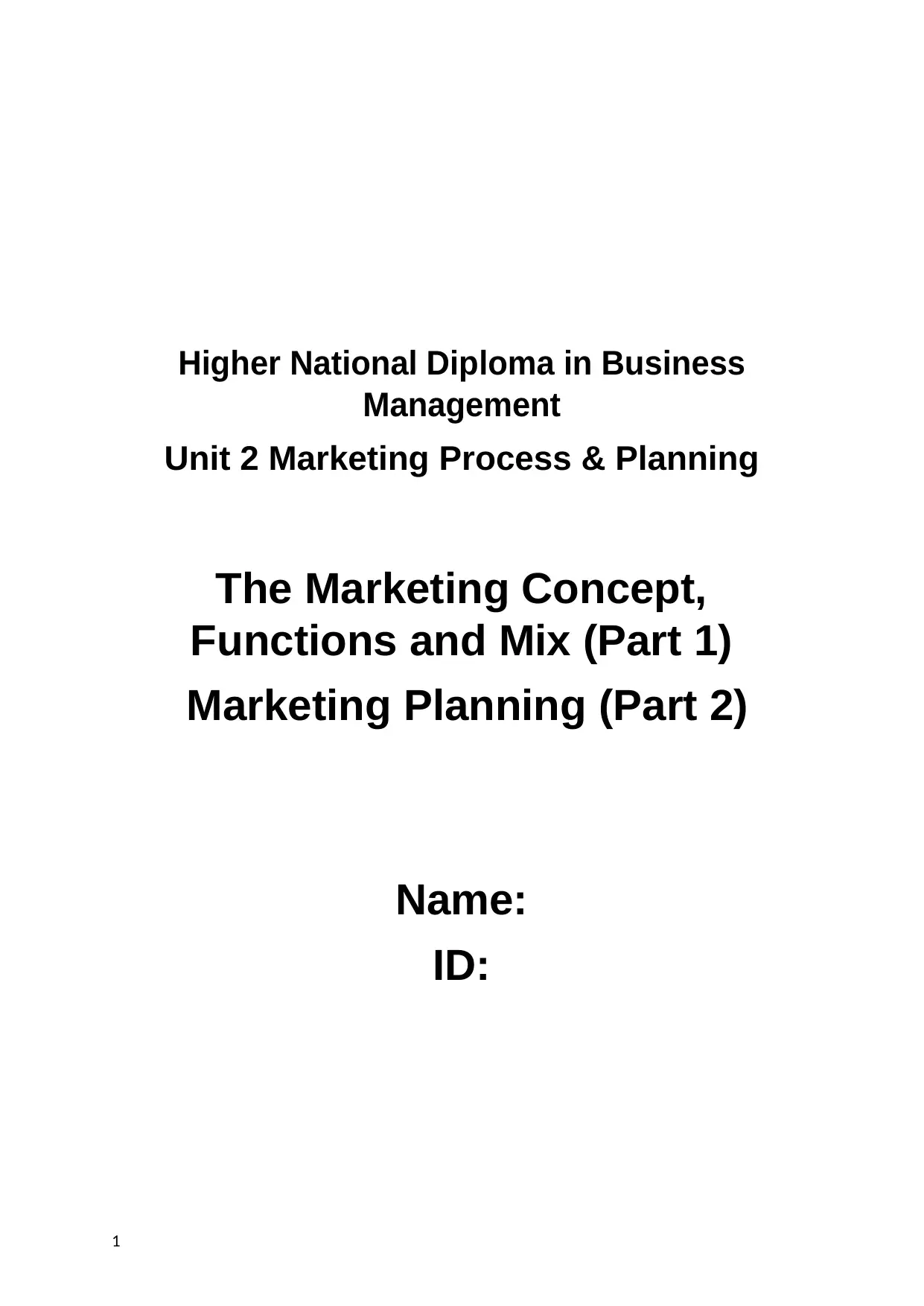
Higher National Diploma in Business
Management
Unit 2 Marketing Process & Planning
The Marketing Concept,
Functions and Mix (Part 1)
Marketing Planning (Part 2)
Name:
ID:
1
Management
Unit 2 Marketing Process & Planning
The Marketing Concept,
Functions and Mix (Part 1)
Marketing Planning (Part 2)
Name:
ID:
1
Secure Best Marks with AI Grader
Need help grading? Try our AI Grader for instant feedback on your assignments.
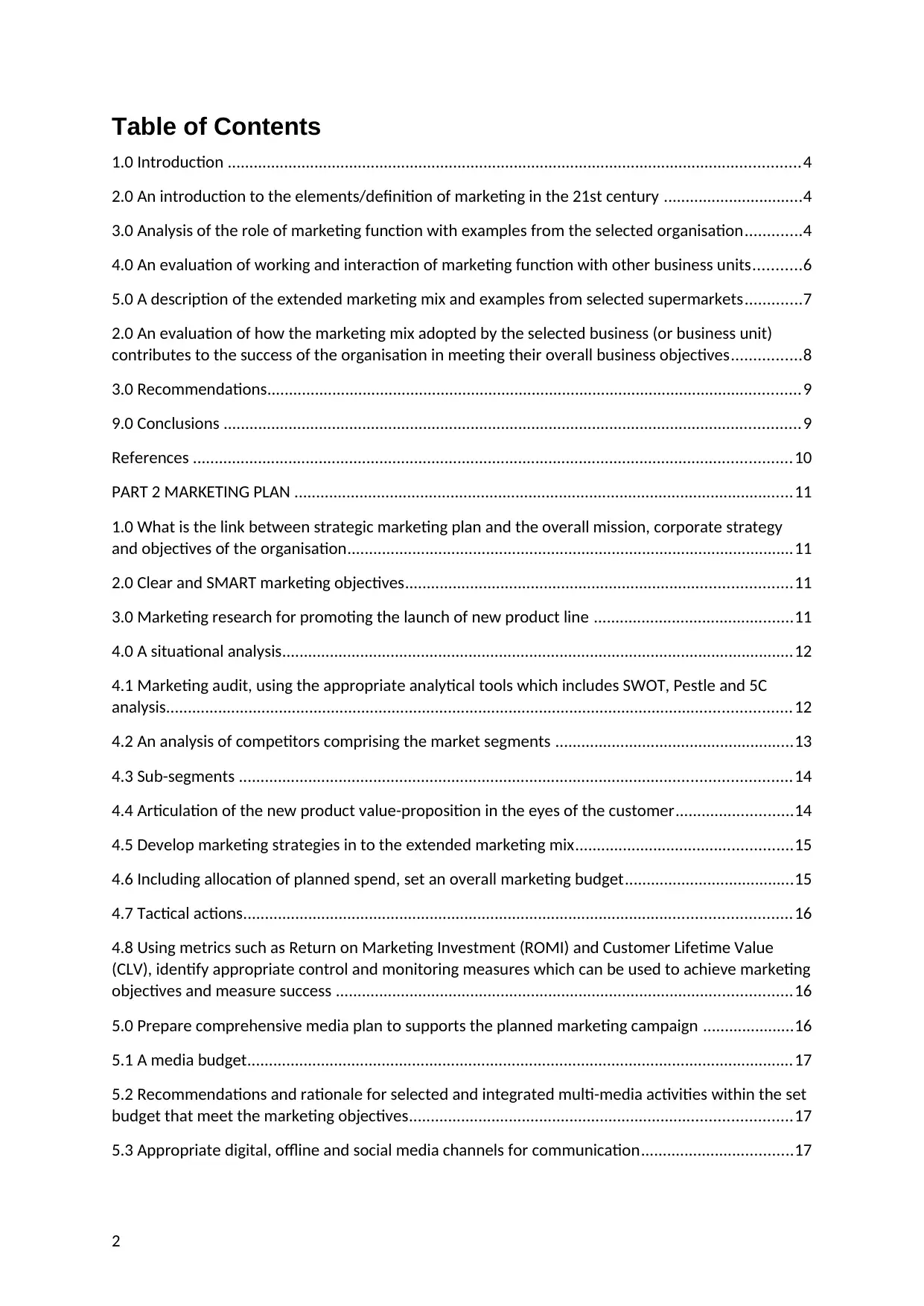
Table of Contents
1.0 Introduction ....................................................................................................................................4
2.0 An introduction to the elements/definition of marketing in the 21st century ................................4
3.0 Analysis of the role of marketing function with examples from the selected organisation.............4
4.0 An evaluation of working and interaction of marketing function with other business units...........6
5.0 A description of the extended marketing mix and examples from selected supermarkets.............7
2.0 An evaluation of how the marketing mix adopted by the selected business (or business unit)
contributes to the success of the organisation in meeting their overall business objectives................8
3.0 Recommendations...........................................................................................................................9
9.0 Conclusions .....................................................................................................................................9
References ..........................................................................................................................................10
PART 2 MARKETING PLAN ...................................................................................................................11
1.0 What is the link between strategic marketing plan and the overall mission, corporate strategy
and objectives of the organisation.......................................................................................................11
2.0 Clear and SMART marketing objectives.........................................................................................11
3.0 Marketing research for promoting the launch of new product line ..............................................11
4.0 A situational analysis......................................................................................................................12
4.1 Marketing audit, using the appropriate analytical tools which includes SWOT, Pestle and 5C
analysis................................................................................................................................................12
4.2 An analysis of competitors comprising the market segments .......................................................13
4.3 Sub-segments ...............................................................................................................................14
4.4 Articulation of the new product value-proposition in the eyes of the customer...........................14
4.5 Develop marketing strategies in to the extended marketing mix..................................................15
4.6 Including allocation of planned spend, set an overall marketing budget.......................................15
4.7 Tactical actions..............................................................................................................................16
4.8 Using metrics such as Return on Marketing Investment (ROMI) and Customer Lifetime Value
(CLV), identify appropriate control and monitoring measures which can be used to achieve marketing
objectives and measure success .........................................................................................................16
5.0 Prepare comprehensive media plan to supports the planned marketing campaign .....................16
5.1 A media budget..............................................................................................................................17
5.2 Recommendations and rationale for selected and integrated multi-media activities within the set
budget that meet the marketing objectives........................................................................................17
5.3 Appropriate digital, offline and social media channels for communication...................................17
2
1.0 Introduction ....................................................................................................................................4
2.0 An introduction to the elements/definition of marketing in the 21st century ................................4
3.0 Analysis of the role of marketing function with examples from the selected organisation.............4
4.0 An evaluation of working and interaction of marketing function with other business units...........6
5.0 A description of the extended marketing mix and examples from selected supermarkets.............7
2.0 An evaluation of how the marketing mix adopted by the selected business (or business unit)
contributes to the success of the organisation in meeting their overall business objectives................8
3.0 Recommendations...........................................................................................................................9
9.0 Conclusions .....................................................................................................................................9
References ..........................................................................................................................................10
PART 2 MARKETING PLAN ...................................................................................................................11
1.0 What is the link between strategic marketing plan and the overall mission, corporate strategy
and objectives of the organisation.......................................................................................................11
2.0 Clear and SMART marketing objectives.........................................................................................11
3.0 Marketing research for promoting the launch of new product line ..............................................11
4.0 A situational analysis......................................................................................................................12
4.1 Marketing audit, using the appropriate analytical tools which includes SWOT, Pestle and 5C
analysis................................................................................................................................................12
4.2 An analysis of competitors comprising the market segments .......................................................13
4.3 Sub-segments ...............................................................................................................................14
4.4 Articulation of the new product value-proposition in the eyes of the customer...........................14
4.5 Develop marketing strategies in to the extended marketing mix..................................................15
4.6 Including allocation of planned spend, set an overall marketing budget.......................................15
4.7 Tactical actions..............................................................................................................................16
4.8 Using metrics such as Return on Marketing Investment (ROMI) and Customer Lifetime Value
(CLV), identify appropriate control and monitoring measures which can be used to achieve marketing
objectives and measure success .........................................................................................................16
5.0 Prepare comprehensive media plan to supports the planned marketing campaign .....................16
5.1 A media budget..............................................................................................................................17
5.2 Recommendations and rationale for selected and integrated multi-media activities within the set
budget that meet the marketing objectives........................................................................................17
5.3 Appropriate digital, offline and social media channels for communication...................................17
2
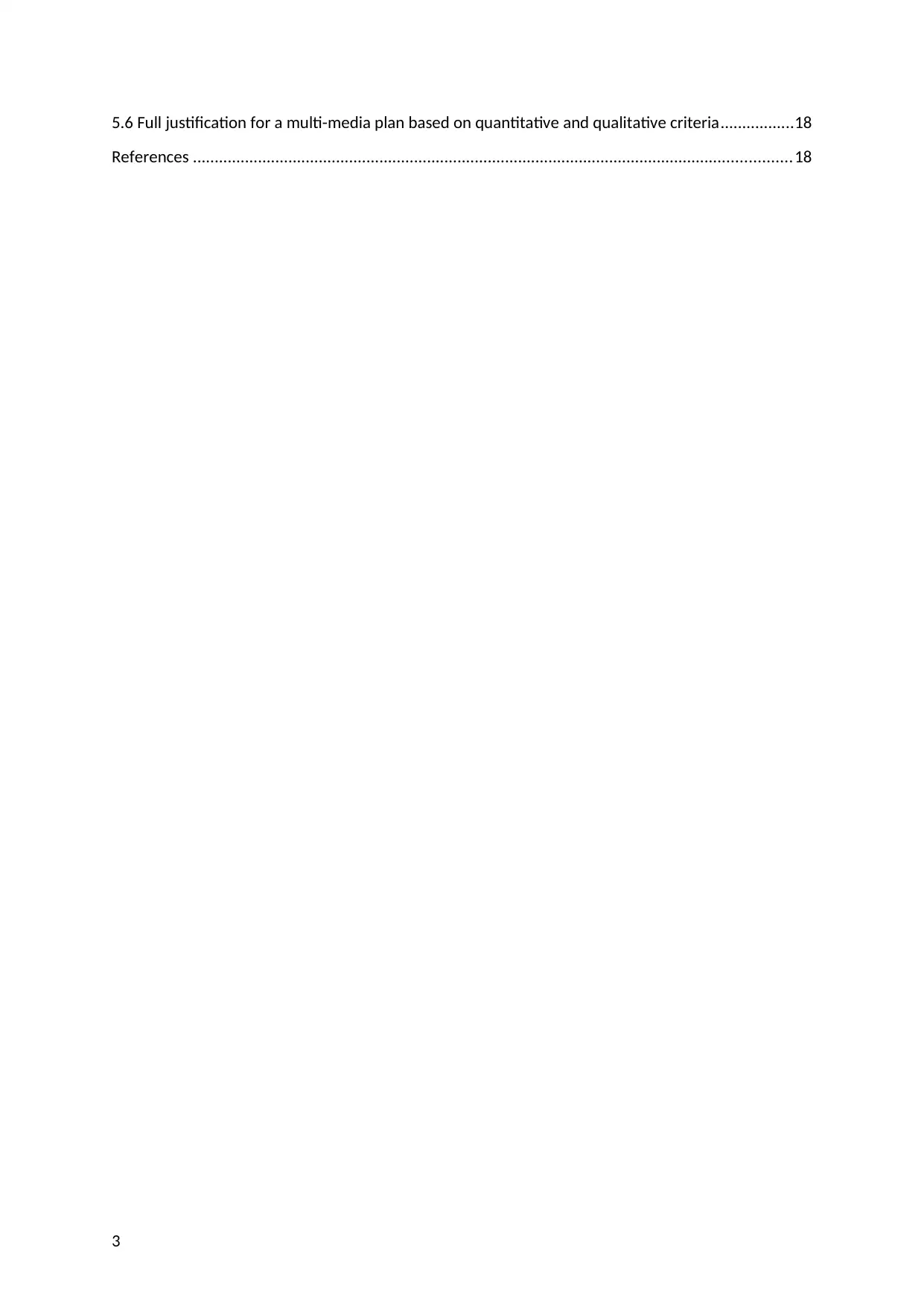
5.6 Full justification for a multi-media plan based on quantitative and qualitative criteria.................18
References ..........................................................................................................................................18
3
References ..........................................................................................................................................18
3
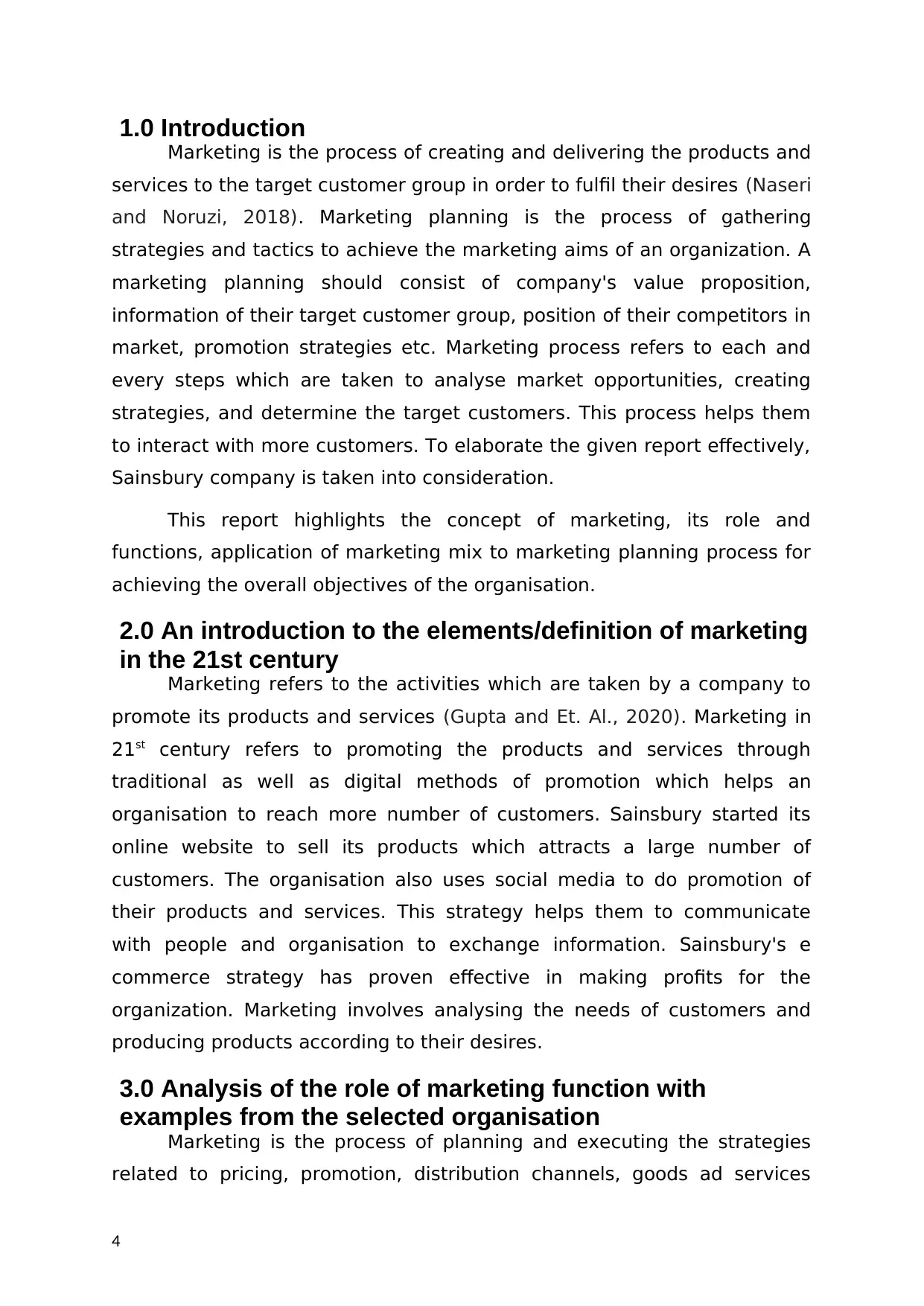
1.0 Introduction
Marketing is the process of creating and delivering the products and
services to the target customer group in order to fulfil their desires (Naseri
and Noruzi, 2018). Marketing planning is the process of gathering
strategies and tactics to achieve the marketing aims of an organization. A
marketing planning should consist of company's value proposition,
information of their target customer group, position of their competitors in
market, promotion strategies etc. Marketing process refers to each and
every steps which are taken to analyse market opportunities, creating
strategies, and determine the target customers. This process helps them
to interact with more customers. To elaborate the given report effectively,
Sainsbury company is taken into consideration.
This report highlights the concept of marketing, its role and
functions, application of marketing mix to marketing planning process for
achieving the overall objectives of the organisation.
2.0 An introduction to the elements/definition of marketing
in the 21st century
Marketing refers to the activities which are taken by a company to
promote its products and services (Gupta and Et. Al., 2020). Marketing in
21st century refers to promoting the products and services through
traditional as well as digital methods of promotion which helps an
organisation to reach more number of customers. Sainsbury started its
online website to sell its products which attracts a large number of
customers. The organisation also uses social media to do promotion of
their products and services. This strategy helps them to communicate
with people and organisation to exchange information. Sainsbury's e
commerce strategy has proven effective in making profits for the
organization. Marketing involves analysing the needs of customers and
producing products according to their desires.
3.0 Analysis of the role of marketing function with
examples from the selected organisation
Marketing is the process of planning and executing the strategies
related to pricing, promotion, distribution channels, goods ad services
4
Marketing is the process of creating and delivering the products and
services to the target customer group in order to fulfil their desires (Naseri
and Noruzi, 2018). Marketing planning is the process of gathering
strategies and tactics to achieve the marketing aims of an organization. A
marketing planning should consist of company's value proposition,
information of their target customer group, position of their competitors in
market, promotion strategies etc. Marketing process refers to each and
every steps which are taken to analyse market opportunities, creating
strategies, and determine the target customers. This process helps them
to interact with more customers. To elaborate the given report effectively,
Sainsbury company is taken into consideration.
This report highlights the concept of marketing, its role and
functions, application of marketing mix to marketing planning process for
achieving the overall objectives of the organisation.
2.0 An introduction to the elements/definition of marketing
in the 21st century
Marketing refers to the activities which are taken by a company to
promote its products and services (Gupta and Et. Al., 2020). Marketing in
21st century refers to promoting the products and services through
traditional as well as digital methods of promotion which helps an
organisation to reach more number of customers. Sainsbury started its
online website to sell its products which attracts a large number of
customers. The organisation also uses social media to do promotion of
their products and services. This strategy helps them to communicate
with people and organisation to exchange information. Sainsbury's e
commerce strategy has proven effective in making profits for the
organization. Marketing involves analysing the needs of customers and
producing products according to their desires.
3.0 Analysis of the role of marketing function with
examples from the selected organisation
Marketing is the process of planning and executing the strategies
related to pricing, promotion, distribution channels, goods ad services
4
Secure Best Marks with AI Grader
Need help grading? Try our AI Grader for instant feedback on your assignments.

(Benzo, Mohsen and Fourali, 2017). Marketing function represent the
important components of marketing process which shows how marketers
help a organisation to succeed. With the help of strategic marketing plan,
the marketing department of Sainsbury have to reach out and attract
more number of customers. If the organisation sell products at lower
prices than it can gain competitive advantage in the market. The
managers of Sainsbury make strategic plan to promote their products and
services in the market place to build a strong customer base. Marketing
function in context to Sainsbury are described below: Pricing: Pricing for a product is the crucial step of marketing, it is
the basis for sale of the product and regarded as one of the most
important part of marketing function. The price of a products
determines whether it will be successful or not. The managers of
Sainsbury identifies a sweet spot which balances how a customer
values the goods with the cost of production and the current price
of competing products. Sainsbury offers price cut on everyday
products like bread, cheese and household products. Promotion: It is the process of creating awareness of products and
services among customers by presenting it through various
promotional channels (Deffner and Et. Al., 2020). The managers of
Sainsbury uses broadcast methods like television, radio and below
the line promotional activities include sales promotion, database
marketing and packaging. The promotional strategies help the
organisation to build promote their brand and build a strong
customer base.
Marketing information management: Data is used to drive
strategies for marketing, collection of more information will result in
success of marketing efforts. The marketing department of
Sainsbury gather information about the target market and
customers, industry competitors and market trends. This
information is shared with other concerned departments to use it in
their functioning. The information helps the team to design the
5
important components of marketing process which shows how marketers
help a organisation to succeed. With the help of strategic marketing plan,
the marketing department of Sainsbury have to reach out and attract
more number of customers. If the organisation sell products at lower
prices than it can gain competitive advantage in the market. The
managers of Sainsbury make strategic plan to promote their products and
services in the market place to build a strong customer base. Marketing
function in context to Sainsbury are described below: Pricing: Pricing for a product is the crucial step of marketing, it is
the basis for sale of the product and regarded as one of the most
important part of marketing function. The price of a products
determines whether it will be successful or not. The managers of
Sainsbury identifies a sweet spot which balances how a customer
values the goods with the cost of production and the current price
of competing products. Sainsbury offers price cut on everyday
products like bread, cheese and household products. Promotion: It is the process of creating awareness of products and
services among customers by presenting it through various
promotional channels (Deffner and Et. Al., 2020). The managers of
Sainsbury uses broadcast methods like television, radio and below
the line promotional activities include sales promotion, database
marketing and packaging. The promotional strategies help the
organisation to build promote their brand and build a strong
customer base.
Marketing information management: Data is used to drive
strategies for marketing, collection of more information will result in
success of marketing efforts. The marketing department of
Sainsbury gather information about the target market and
customers, industry competitors and market trends. This
information is shared with other concerned departments to use it in
their functioning. The information helps the team to design the
5
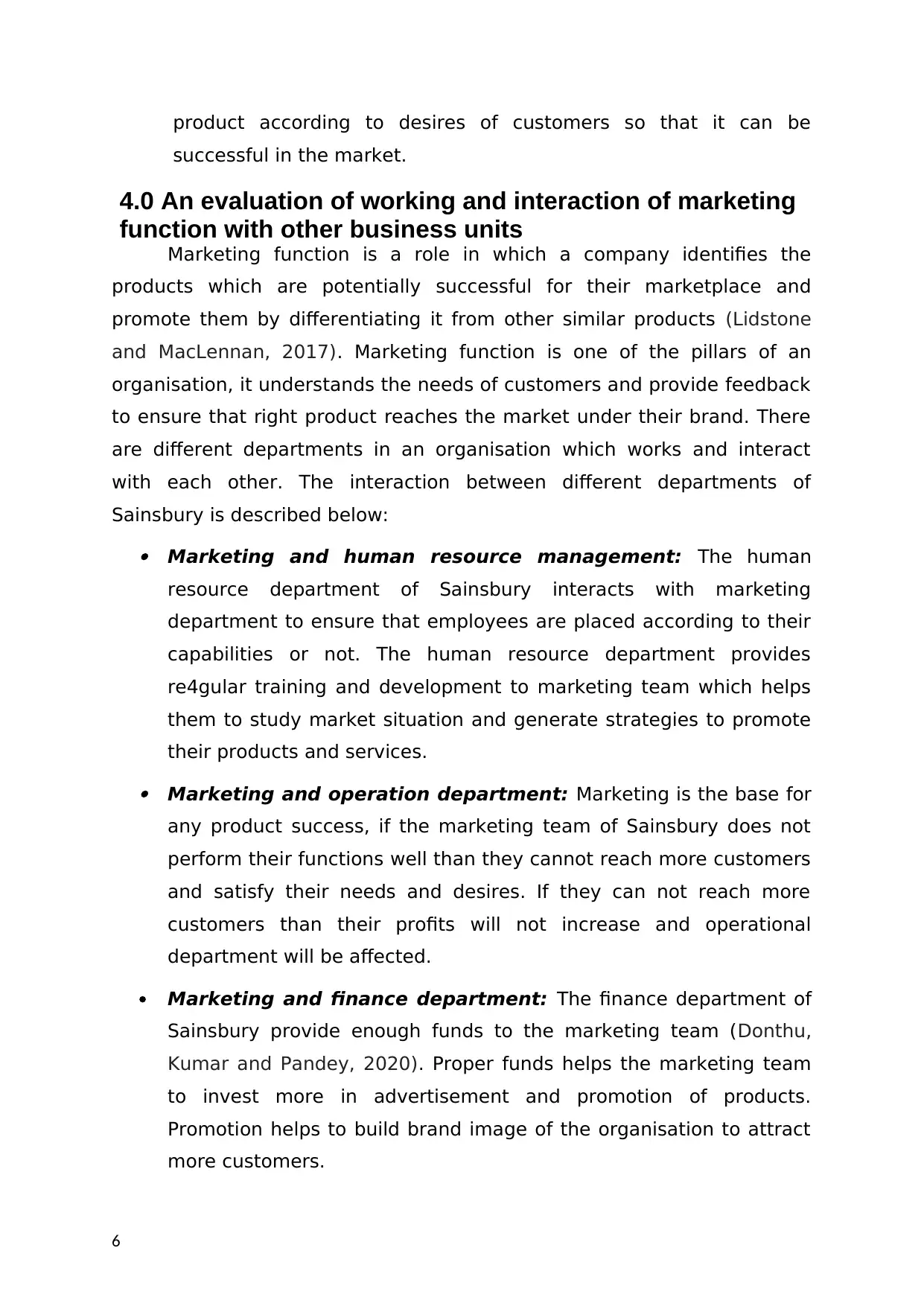
product according to desires of customers so that it can be
successful in the market.
4.0 An evaluation of working and interaction of marketing
function with other business units
Marketing function is a role in which a company identifies the
products which are potentially successful for their marketplace and
promote them by differentiating it from other similar products (Lidstone
and MacLennan, 2017). Marketing function is one of the pillars of an
organisation, it understands the needs of customers and provide feedback
to ensure that right product reaches the market under their brand. There
are different departments in an organisation which works and interact
with each other. The interaction between different departments of
Sainsbury is described below: Marketing and human resource management: The human
resource department of Sainsbury interacts with marketing
department to ensure that employees are placed according to their
capabilities or not. The human resource department provides
re4gular training and development to marketing team which helps
them to study market situation and generate strategies to promote
their products and services. Marketing and operation department: Marketing is the base for
any product success, if the marketing team of Sainsbury does not
perform their functions well than they cannot reach more customers
and satisfy their needs and desires. If they can not reach more
customers than their profits will not increase and operational
department will be affected.
Marketing and finance department: The finance department of
Sainsbury provide enough funds to the marketing team (Donthu,
Kumar and Pandey, 2020). Proper funds helps the marketing team
to invest more in advertisement and promotion of products.
Promotion helps to build brand image of the organisation to attract
more customers.
6
successful in the market.
4.0 An evaluation of working and interaction of marketing
function with other business units
Marketing function is a role in which a company identifies the
products which are potentially successful for their marketplace and
promote them by differentiating it from other similar products (Lidstone
and MacLennan, 2017). Marketing function is one of the pillars of an
organisation, it understands the needs of customers and provide feedback
to ensure that right product reaches the market under their brand. There
are different departments in an organisation which works and interact
with each other. The interaction between different departments of
Sainsbury is described below: Marketing and human resource management: The human
resource department of Sainsbury interacts with marketing
department to ensure that employees are placed according to their
capabilities or not. The human resource department provides
re4gular training and development to marketing team which helps
them to study market situation and generate strategies to promote
their products and services. Marketing and operation department: Marketing is the base for
any product success, if the marketing team of Sainsbury does not
perform their functions well than they cannot reach more customers
and satisfy their needs and desires. If they can not reach more
customers than their profits will not increase and operational
department will be affected.
Marketing and finance department: The finance department of
Sainsbury provide enough funds to the marketing team (Donthu,
Kumar and Pandey, 2020). Proper funds helps the marketing team
to invest more in advertisement and promotion of products.
Promotion helps to build brand image of the organisation to attract
more customers.
6
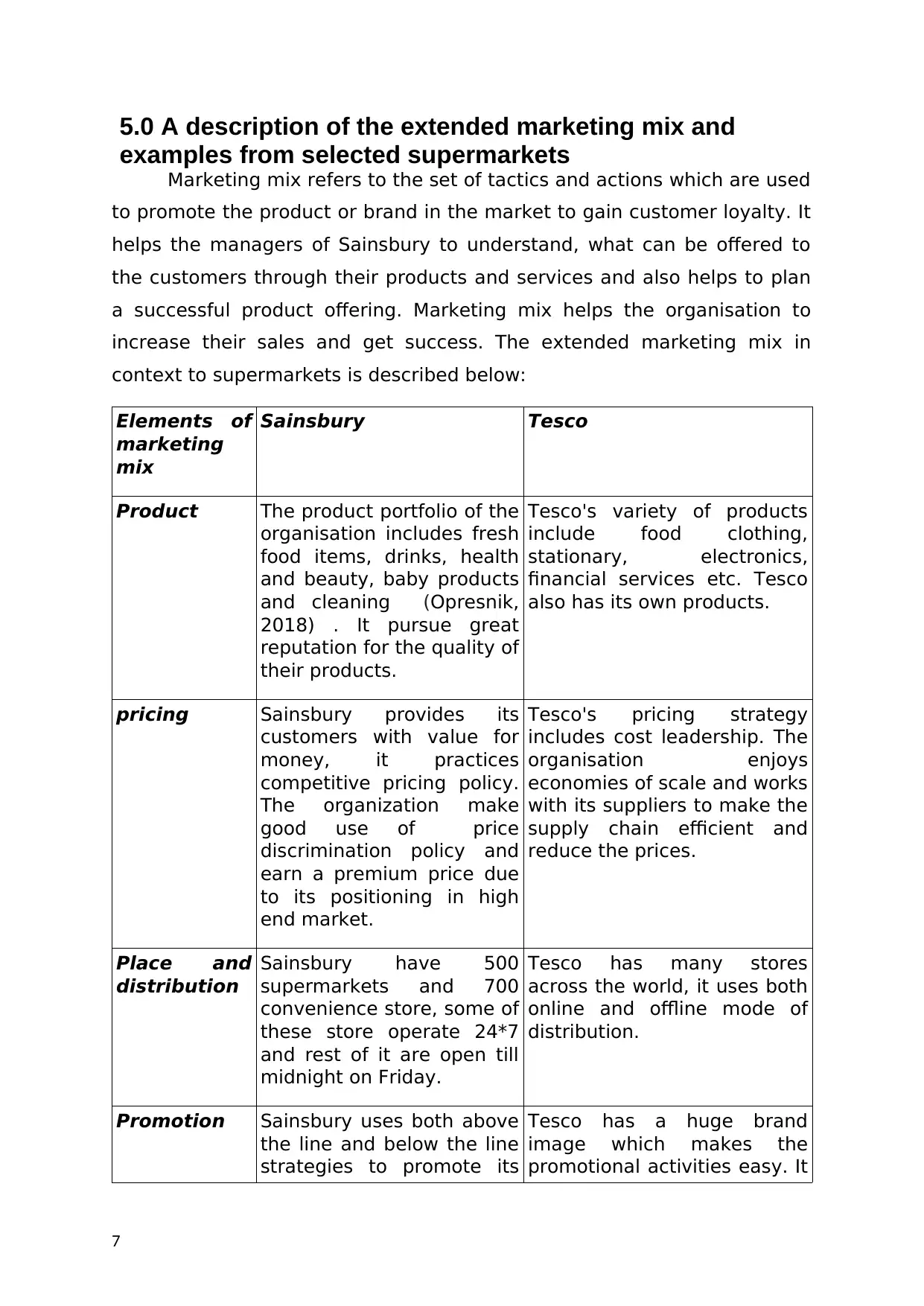
5.0 A description of the extended marketing mix and
examples from selected supermarkets
Marketing mix refers to the set of tactics and actions which are used
to promote the product or brand in the market to gain customer loyalty. It
helps the managers of Sainsbury to understand, what can be offered to
the customers through their products and services and also helps to plan
a successful product offering. Marketing mix helps the organisation to
increase their sales and get success. The extended marketing mix in
context to supermarkets is described below:
Elements of
marketing
mix
Sainsbury Tesco
Product The product portfolio of the
organisation includes fresh
food items, drinks, health
and beauty, baby products
and cleaning (Opresnik,
2018) . It pursue great
reputation for the quality of
their products.
Tesco's variety of products
include food clothing,
stationary, electronics,
financial services etc. Tesco
also has its own products.
pricing Sainsbury provides its
customers with value for
money, it practices
competitive pricing policy.
The organization make
good use of price
discrimination policy and
earn a premium price due
to its positioning in high
end market.
Tesco's pricing strategy
includes cost leadership. The
organisation enjoys
economies of scale and works
with its suppliers to make the
supply chain efficient and
reduce the prices.
Place and
distribution
Sainsbury have 500
supermarkets and 700
convenience store, some of
these store operate 24*7
and rest of it are open till
midnight on Friday.
Tesco has many stores
across the world, it uses both
online and offline mode of
distribution.
Promotion Sainsbury uses both above
the line and below the line
strategies to promote its
Tesco has a huge brand
image which makes the
promotional activities easy. It
7
examples from selected supermarkets
Marketing mix refers to the set of tactics and actions which are used
to promote the product or brand in the market to gain customer loyalty. It
helps the managers of Sainsbury to understand, what can be offered to
the customers through their products and services and also helps to plan
a successful product offering. Marketing mix helps the organisation to
increase their sales and get success. The extended marketing mix in
context to supermarkets is described below:
Elements of
marketing
mix
Sainsbury Tesco
Product The product portfolio of the
organisation includes fresh
food items, drinks, health
and beauty, baby products
and cleaning (Opresnik,
2018) . It pursue great
reputation for the quality of
their products.
Tesco's variety of products
include food clothing,
stationary, electronics,
financial services etc. Tesco
also has its own products.
pricing Sainsbury provides its
customers with value for
money, it practices
competitive pricing policy.
The organization make
good use of price
discrimination policy and
earn a premium price due
to its positioning in high
end market.
Tesco's pricing strategy
includes cost leadership. The
organisation enjoys
economies of scale and works
with its suppliers to make the
supply chain efficient and
reduce the prices.
Place and
distribution
Sainsbury have 500
supermarkets and 700
convenience store, some of
these store operate 24*7
and rest of it are open till
midnight on Friday.
Tesco has many stores
across the world, it uses both
online and offline mode of
distribution.
Promotion Sainsbury uses both above
the line and below the line
strategies to promote its
Tesco has a huge brand
image which makes the
promotional activities easy. It
7
Paraphrase This Document
Need a fresh take? Get an instant paraphrase of this document with our AI Paraphraser

products. The strategies
include television, radio to
communicate, sales
promotion, database
marketing and packaging.
uses television, newspapers,
other media outlets to
communicate with
customers. It also provides
offers at their stores to
attract more customers.
People Sainsbury have well
trained experts and
professionals who well
understands the consumer
behaviour and gives first
preference to the
customers.
There are many people
working in the organisation
who are customer oriented.
The organisation invests
huge amount on the training
and development of the
employees.
Process The online shopping
strategy of Sainsbury has
increased its order
numbers and gained
customer loyalty
(Matušínská and Stoklasa,
2019).
Process is the set of activities
performed in the Tesco store.
The customers pick their
products and go to the
counters t pay, they can also
use self service machines to
make payment.
Physical
evidence
Sainsbury have different
store designs and layouts
which addresses varied
needs of customers.
The logo of Tesco is excellent
with efficient use of colour.
The offline store of the
company are easy to access
and products are well
arranged.
2.0 An evaluation of how the marketing mix adopted by
the selected business (or business unit) contributes to the
success of the organisation in meeting their overall
business objectives
Marketing mix is the set of techniques which are used by the
organisation to promote their products and brand (THIS, 2020). Good
marketing helps in attracting large number of customers to increase their
brand reputation. Marketing mix helps the managers of Sainsbury to
achieve their goals and objectives. It help them to analyse the return on
8
include television, radio to
communicate, sales
promotion, database
marketing and packaging.
uses television, newspapers,
other media outlets to
communicate with
customers. It also provides
offers at their stores to
attract more customers.
People Sainsbury have well
trained experts and
professionals who well
understands the consumer
behaviour and gives first
preference to the
customers.
There are many people
working in the organisation
who are customer oriented.
The organisation invests
huge amount on the training
and development of the
employees.
Process The online shopping
strategy of Sainsbury has
increased its order
numbers and gained
customer loyalty
(Matušínská and Stoklasa,
2019).
Process is the set of activities
performed in the Tesco store.
The customers pick their
products and go to the
counters t pay, they can also
use self service machines to
make payment.
Physical
evidence
Sainsbury have different
store designs and layouts
which addresses varied
needs of customers.
The logo of Tesco is excellent
with efficient use of colour.
The offline store of the
company are easy to access
and products are well
arranged.
2.0 An evaluation of how the marketing mix adopted by
the selected business (or business unit) contributes to the
success of the organisation in meeting their overall
business objectives
Marketing mix is the set of techniques which are used by the
organisation to promote their products and brand (THIS, 2020). Good
marketing helps in attracting large number of customers to increase their
brand reputation. Marketing mix helps the managers of Sainsbury to
achieve their goals and objectives. It help them to analyse the return on
8
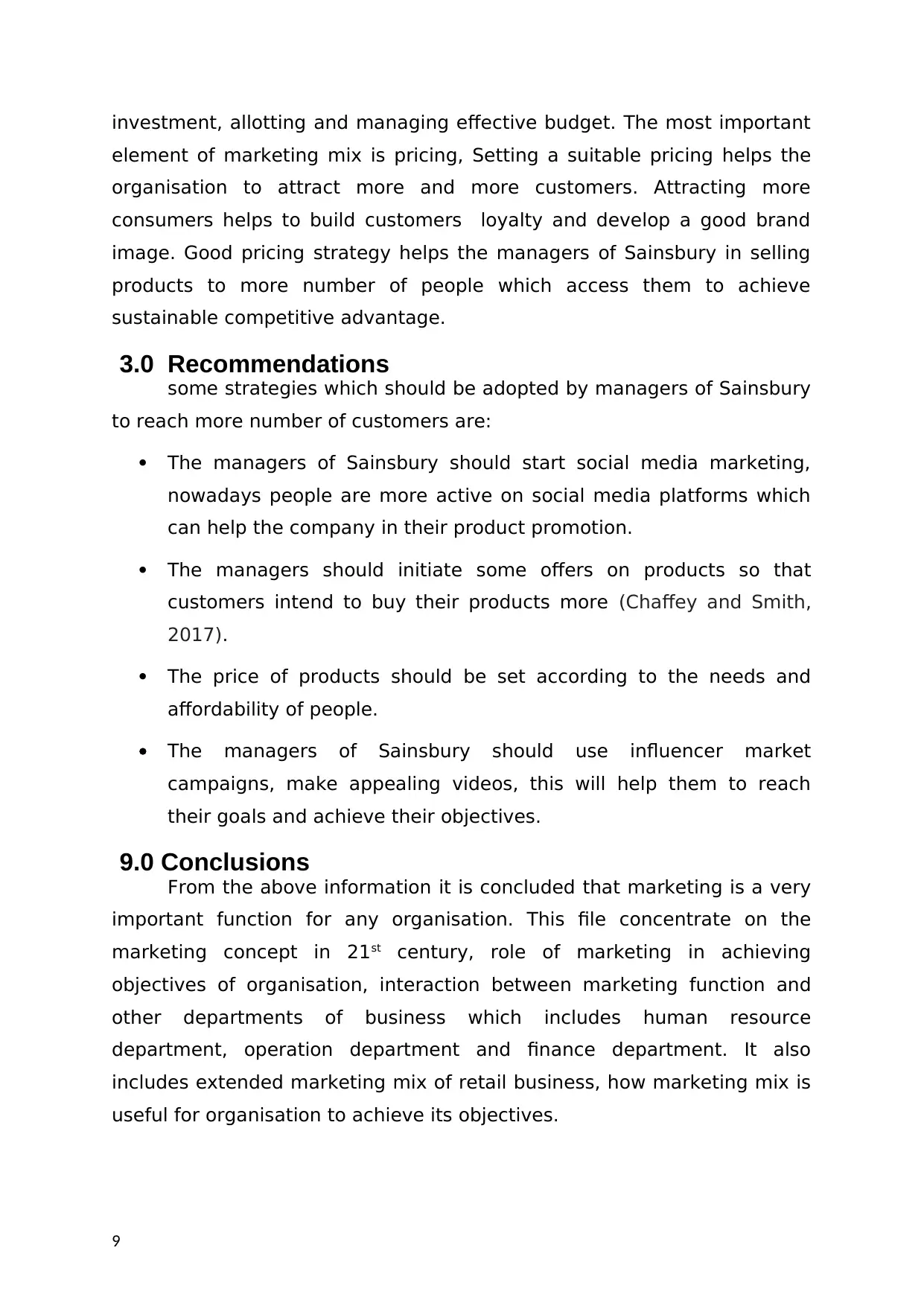
investment, allotting and managing effective budget. The most important
element of marketing mix is pricing, Setting a suitable pricing helps the
organisation to attract more and more customers. Attracting more
consumers helps to build customers loyalty and develop a good brand
image. Good pricing strategy helps the managers of Sainsbury in selling
products to more number of people which access them to achieve
sustainable competitive advantage.
3.0 Recommendations
some strategies which should be adopted by managers of Sainsbury
to reach more number of customers are:
The managers of Sainsbury should start social media marketing,
nowadays people are more active on social media platforms which
can help the company in their product promotion.
The managers should initiate some offers on products so that
customers intend to buy their products more (Chaffey and Smith,
2017).
The price of products should be set according to the needs and
affordability of people.
The managers of Sainsbury should use influencer market
campaigns, make appealing videos, this will help them to reach
their goals and achieve their objectives.
9.0 Conclusions
From the above information it is concluded that marketing is a very
important function for any organisation. This file concentrate on the
marketing concept in 21st century, role of marketing in achieving
objectives of organisation, interaction between marketing function and
other departments of business which includes human resource
department, operation department and finance department. It also
includes extended marketing mix of retail business, how marketing mix is
useful for organisation to achieve its objectives.
9
element of marketing mix is pricing, Setting a suitable pricing helps the
organisation to attract more and more customers. Attracting more
consumers helps to build customers loyalty and develop a good brand
image. Good pricing strategy helps the managers of Sainsbury in selling
products to more number of people which access them to achieve
sustainable competitive advantage.
3.0 Recommendations
some strategies which should be adopted by managers of Sainsbury
to reach more number of customers are:
The managers of Sainsbury should start social media marketing,
nowadays people are more active on social media platforms which
can help the company in their product promotion.
The managers should initiate some offers on products so that
customers intend to buy their products more (Chaffey and Smith,
2017).
The price of products should be set according to the needs and
affordability of people.
The managers of Sainsbury should use influencer market
campaigns, make appealing videos, this will help them to reach
their goals and achieve their objectives.
9.0 Conclusions
From the above information it is concluded that marketing is a very
important function for any organisation. This file concentrate on the
marketing concept in 21st century, role of marketing in achieving
objectives of organisation, interaction between marketing function and
other departments of business which includes human resource
department, operation department and finance department. It also
includes extended marketing mix of retail business, how marketing mix is
useful for organisation to achieve its objectives.
9
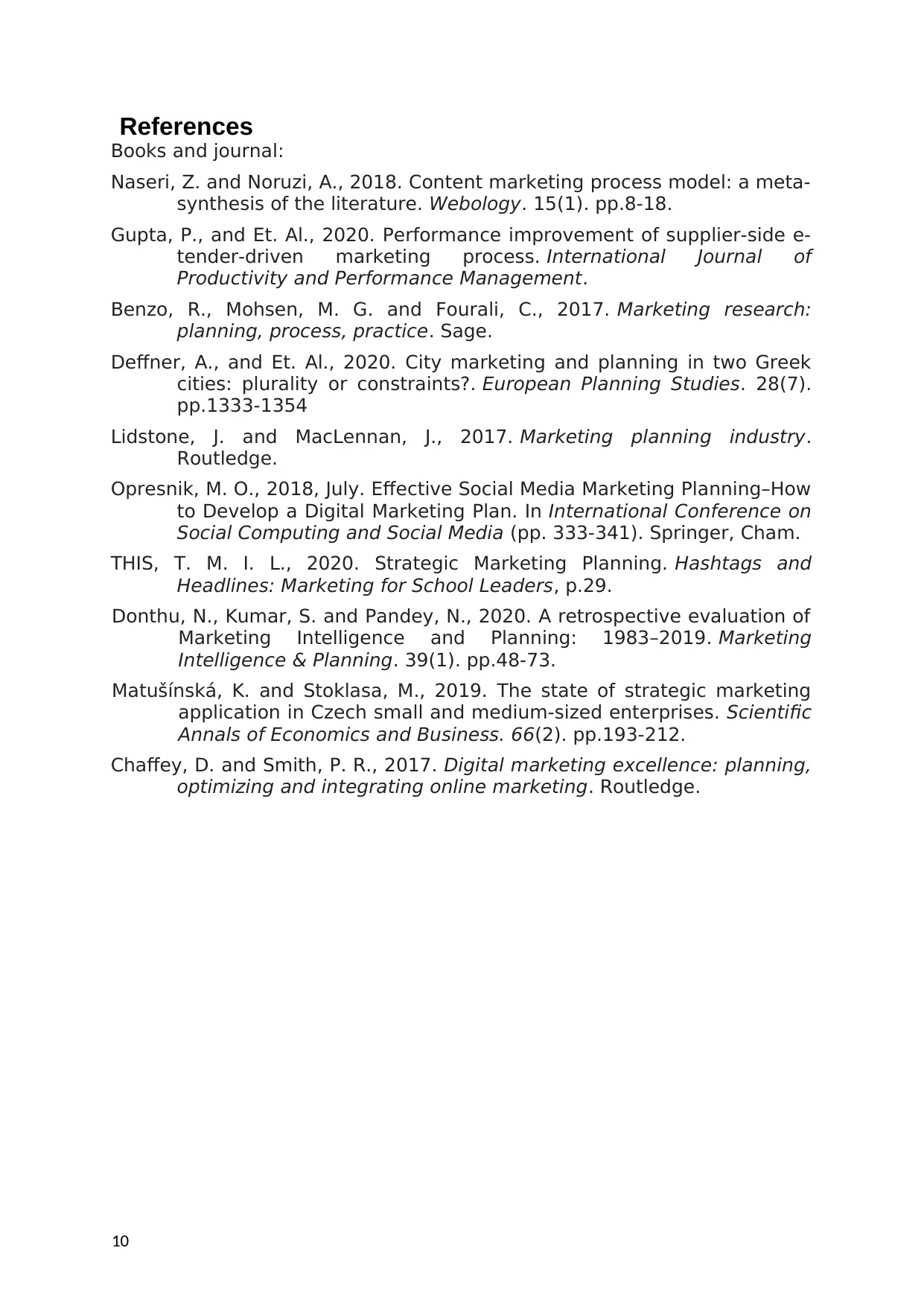
References
Books and journal:
Naseri, Z. and Noruzi, A., 2018. Content marketing process model: a meta-
synthesis of the literature. Webology. 15(1). pp.8-18.
Gupta, P., and Et. Al., 2020. Performance improvement of supplier-side e-
tender-driven marketing process. International Journal of
Productivity and Performance Management.
Benzo, R., Mohsen, M. G. and Fourali, C., 2017. Marketing research:
planning, process, practice. Sage.
Deffner, A., and Et. Al., 2020. City marketing and planning in two Greek
cities: plurality or constraints?. European Planning Studies. 28(7).
pp.1333-1354
Lidstone, J. and MacLennan, J., 2017. Marketing planning industry.
Routledge.
Opresnik, M. O., 2018, July. Effective Social Media Marketing Planning–How
to Develop a Digital Marketing Plan. In International Conference on
Social Computing and Social Media (pp. 333-341). Springer, Cham.
THIS, T. M. I. L., 2020. Strategic Marketing Planning. Hashtags and
Headlines: Marketing for School Leaders, p.29.
Donthu, N., Kumar, S. and Pandey, N., 2020. A retrospective evaluation of
Marketing Intelligence and Planning: 1983–2019. Marketing
Intelligence & Planning. 39(1). pp.48-73.
Matušínská, K. and Stoklasa, M., 2019. The state of strategic marketing
application in Czech small and medium-sized enterprises. Scientific
Annals of Economics and Business. 66(2). pp.193-212.
Chaffey, D. and Smith, P. R., 2017. Digital marketing excellence: planning,
optimizing and integrating online marketing. Routledge.
10
Books and journal:
Naseri, Z. and Noruzi, A., 2018. Content marketing process model: a meta-
synthesis of the literature. Webology. 15(1). pp.8-18.
Gupta, P., and Et. Al., 2020. Performance improvement of supplier-side e-
tender-driven marketing process. International Journal of
Productivity and Performance Management.
Benzo, R., Mohsen, M. G. and Fourali, C., 2017. Marketing research:
planning, process, practice. Sage.
Deffner, A., and Et. Al., 2020. City marketing and planning in two Greek
cities: plurality or constraints?. European Planning Studies. 28(7).
pp.1333-1354
Lidstone, J. and MacLennan, J., 2017. Marketing planning industry.
Routledge.
Opresnik, M. O., 2018, July. Effective Social Media Marketing Planning–How
to Develop a Digital Marketing Plan. In International Conference on
Social Computing and Social Media (pp. 333-341). Springer, Cham.
THIS, T. M. I. L., 2020. Strategic Marketing Planning. Hashtags and
Headlines: Marketing for School Leaders, p.29.
Donthu, N., Kumar, S. and Pandey, N., 2020. A retrospective evaluation of
Marketing Intelligence and Planning: 1983–2019. Marketing
Intelligence & Planning. 39(1). pp.48-73.
Matušínská, K. and Stoklasa, M., 2019. The state of strategic marketing
application in Czech small and medium-sized enterprises. Scientific
Annals of Economics and Business. 66(2). pp.193-212.
Chaffey, D. and Smith, P. R., 2017. Digital marketing excellence: planning,
optimizing and integrating online marketing. Routledge.
10
Secure Best Marks with AI Grader
Need help grading? Try our AI Grader for instant feedback on your assignments.

PART 2 MARKETING PLAN
1.0 What is the link between strategic marketing plan and
the overall mission, corporate strategy and objectives of
the organisation
Strategic marketing plan is a series which helps in guiding the
organization to develop marketing strategies in order to achieve the goals
and objectives of the organization and increase the profitability (Berman
and Thelen, 2018). Strategic planning includes goals, objectives,
strategies etc. Stating marketing strategies helps an organization to
clearly identify what steps it has to take to reach the goals. The managers
of Sainsbury use strategic market plan to get competitive advantage in
the market.
2.0 Clear and SMART marketing objectives
The SMART objectives in context to Sainsbury are:
The company tends to increase its sale by 10% within 6 months by
adding new product and changing promotion strategies.
The managers of Sainsbury will conduct four campaigns at different
places to boost its reputation in the market.
The managers of Sainsbury are planning to implement cross selling
strategies which will help to retain customers by 7% till the end of
2022.
The company will aware people about the new product launch
through email campaign and aware the customers.
3.0 Marketing research for promoting the launch of new product
line
The new product line of any retail store can include the launch of
organic and vegan products (Biroscak and Et. Al., 2018). The managers of
Sainsbury will identify the target market and customers. They will
evaluate the demand of customers and accordingly plan the strategies.
The organization will be able to attract more number of customers by
determining the needs and desires of the customers. They introduced the
product in only few stores to evaluate the demand of the goods. They also
11
1.0 What is the link between strategic marketing plan and
the overall mission, corporate strategy and objectives of
the organisation
Strategic marketing plan is a series which helps in guiding the
organization to develop marketing strategies in order to achieve the goals
and objectives of the organization and increase the profitability (Berman
and Thelen, 2018). Strategic planning includes goals, objectives,
strategies etc. Stating marketing strategies helps an organization to
clearly identify what steps it has to take to reach the goals. The managers
of Sainsbury use strategic market plan to get competitive advantage in
the market.
2.0 Clear and SMART marketing objectives
The SMART objectives in context to Sainsbury are:
The company tends to increase its sale by 10% within 6 months by
adding new product and changing promotion strategies.
The managers of Sainsbury will conduct four campaigns at different
places to boost its reputation in the market.
The managers of Sainsbury are planning to implement cross selling
strategies which will help to retain customers by 7% till the end of
2022.
The company will aware people about the new product launch
through email campaign and aware the customers.
3.0 Marketing research for promoting the launch of new product
line
The new product line of any retail store can include the launch of
organic and vegan products (Biroscak and Et. Al., 2018). The managers of
Sainsbury will identify the target market and customers. They will
evaluate the demand of customers and accordingly plan the strategies.
The organization will be able to attract more number of customers by
determining the needs and desires of the customers. They introduced the
product in only few stores to evaluate the demand of the goods. They also
11
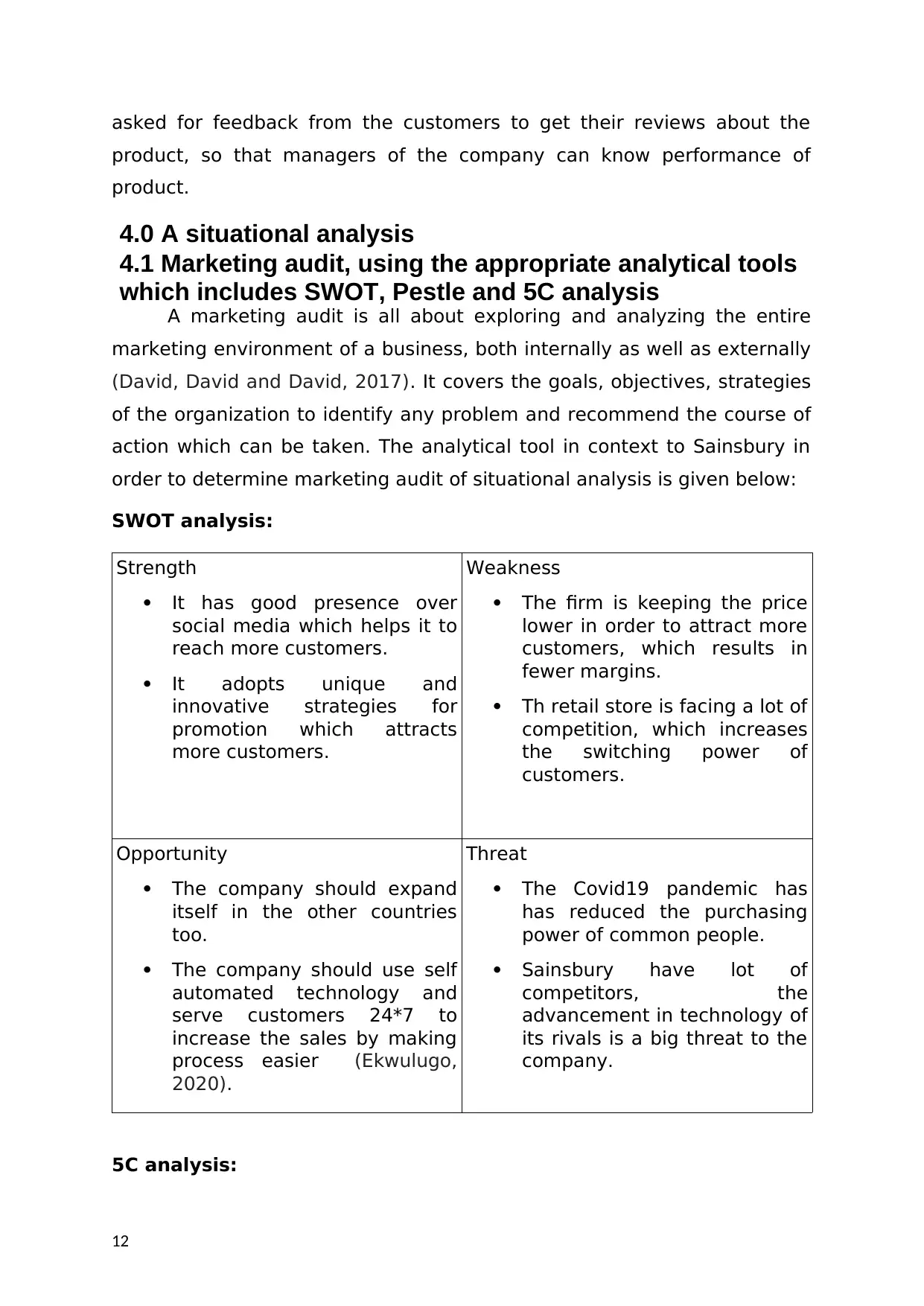
asked for feedback from the customers to get their reviews about the
product, so that managers of the company can know performance of
product.
4.0 A situational analysis
4.1 Marketing audit, using the appropriate analytical tools
which includes SWOT, Pestle and 5C analysis
A marketing audit is all about exploring and analyzing the entire
marketing environment of a business, both internally as well as externally
(David, David and David, 2017). It covers the goals, objectives, strategies
of the organization to identify any problem and recommend the course of
action which can be taken. The analytical tool in context to Sainsbury in
order to determine marketing audit of situational analysis is given below:
SWOT analysis:
Strength
It has good presence over
social media which helps it to
reach more customers.
It adopts unique and
innovative strategies for
promotion which attracts
more customers.
Weakness
The firm is keeping the price
lower in order to attract more
customers, which results in
fewer margins.
Th retail store is facing a lot of
competition, which increases
the switching power of
customers.
Opportunity
The company should expand
itself in the other countries
too.
The company should use self
automated technology and
serve customers 24*7 to
increase the sales by making
process easier (Ekwulugo,
2020).
Threat
The Covid19 pandemic has
has reduced the purchasing
power of common people.
Sainsbury have lot of
competitors, the
advancement in technology of
its rivals is a big threat to the
company.
5C analysis:
12
product, so that managers of the company can know performance of
product.
4.0 A situational analysis
4.1 Marketing audit, using the appropriate analytical tools
which includes SWOT, Pestle and 5C analysis
A marketing audit is all about exploring and analyzing the entire
marketing environment of a business, both internally as well as externally
(David, David and David, 2017). It covers the goals, objectives, strategies
of the organization to identify any problem and recommend the course of
action which can be taken. The analytical tool in context to Sainsbury in
order to determine marketing audit of situational analysis is given below:
SWOT analysis:
Strength
It has good presence over
social media which helps it to
reach more customers.
It adopts unique and
innovative strategies for
promotion which attracts
more customers.
Weakness
The firm is keeping the price
lower in order to attract more
customers, which results in
fewer margins.
Th retail store is facing a lot of
competition, which increases
the switching power of
customers.
Opportunity
The company should expand
itself in the other countries
too.
The company should use self
automated technology and
serve customers 24*7 to
increase the sales by making
process easier (Ekwulugo,
2020).
Threat
The Covid19 pandemic has
has reduced the purchasing
power of common people.
Sainsbury have lot of
competitors, the
advancement in technology of
its rivals is a big threat to the
company.
5C analysis:
12
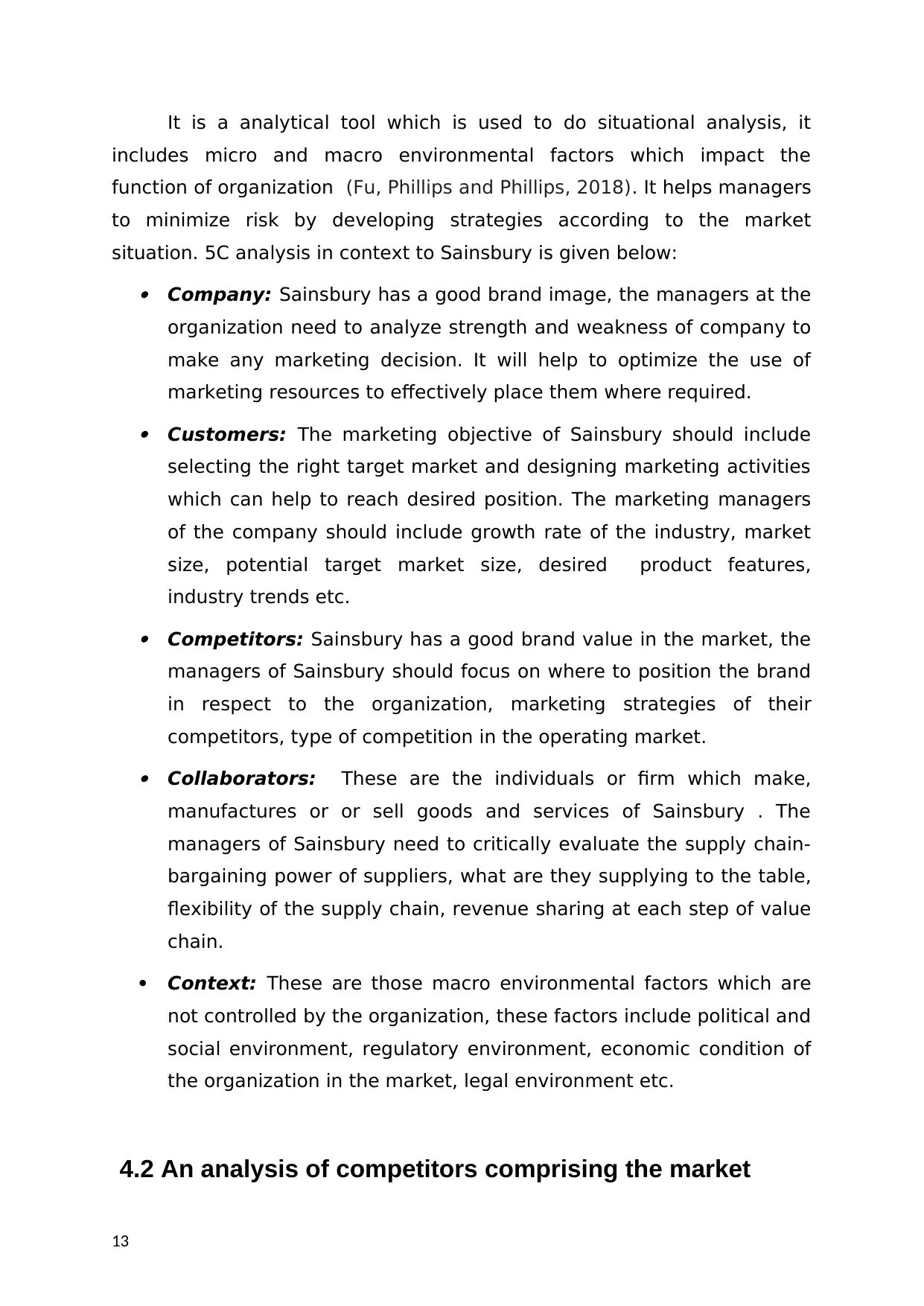
It is a analytical tool which is used to do situational analysis, it
includes micro and macro environmental factors which impact the
function of organization (Fu, Phillips and Phillips, 2018). It helps managers
to minimize risk by developing strategies according to the market
situation. 5C analysis in context to Sainsbury is given below: Company: Sainsbury has a good brand image, the managers at the
organization need to analyze strength and weakness of company to
make any marketing decision. It will help to optimize the use of
marketing resources to effectively place them where required. Customers: The marketing objective of Sainsbury should include
selecting the right target market and designing marketing activities
which can help to reach desired position. The marketing managers
of the company should include growth rate of the industry, market
size, potential target market size, desired product features,
industry trends etc. Competitors: Sainsbury has a good brand value in the market, the
managers of Sainsbury should focus on where to position the brand
in respect to the organization, marketing strategies of their
competitors, type of competition in the operating market. Collaborators: These are the individuals or firm which make,
manufactures or or sell goods and services of Sainsbury . The
managers of Sainsbury need to critically evaluate the supply chain-
bargaining power of suppliers, what are they supplying to the table,
flexibility of the supply chain, revenue sharing at each step of value
chain.
Context: These are those macro environmental factors which are
not controlled by the organization, these factors include political and
social environment, regulatory environment, economic condition of
the organization in the market, legal environment etc.
4.2 An analysis of competitors comprising the market
13
includes micro and macro environmental factors which impact the
function of organization (Fu, Phillips and Phillips, 2018). It helps managers
to minimize risk by developing strategies according to the market
situation. 5C analysis in context to Sainsbury is given below: Company: Sainsbury has a good brand image, the managers at the
organization need to analyze strength and weakness of company to
make any marketing decision. It will help to optimize the use of
marketing resources to effectively place them where required. Customers: The marketing objective of Sainsbury should include
selecting the right target market and designing marketing activities
which can help to reach desired position. The marketing managers
of the company should include growth rate of the industry, market
size, potential target market size, desired product features,
industry trends etc. Competitors: Sainsbury has a good brand value in the market, the
managers of Sainsbury should focus on where to position the brand
in respect to the organization, marketing strategies of their
competitors, type of competition in the operating market. Collaborators: These are the individuals or firm which make,
manufactures or or sell goods and services of Sainsbury . The
managers of Sainsbury need to critically evaluate the supply chain-
bargaining power of suppliers, what are they supplying to the table,
flexibility of the supply chain, revenue sharing at each step of value
chain.
Context: These are those macro environmental factors which are
not controlled by the organization, these factors include political and
social environment, regulatory environment, economic condition of
the organization in the market, legal environment etc.
4.2 An analysis of competitors comprising the market
13
Paraphrase This Document
Need a fresh take? Get an instant paraphrase of this document with our AI Paraphraser
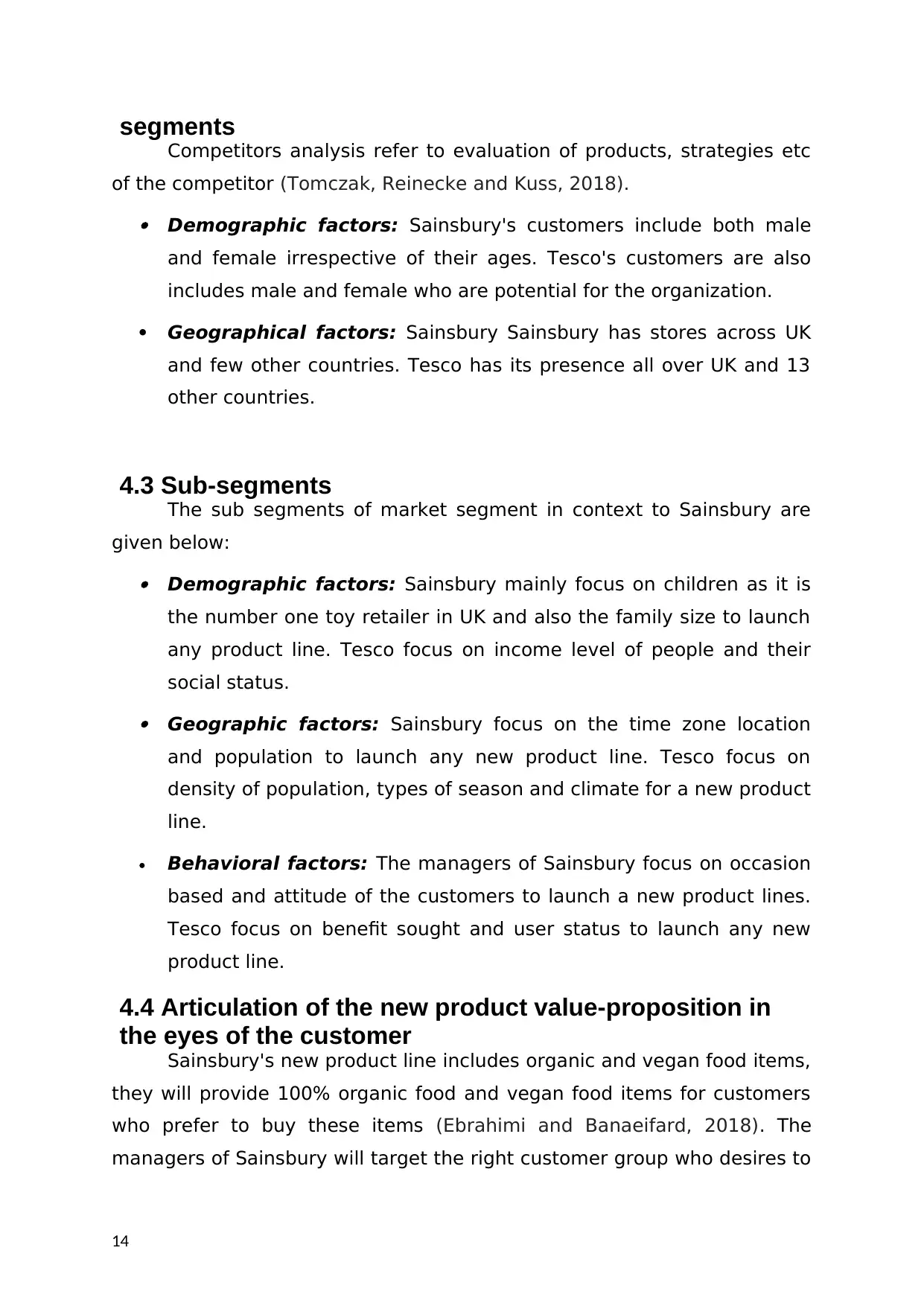
segments
Competitors analysis refer to evaluation of products, strategies etc
of the competitor (Tomczak, Reinecke and Kuss, 2018). Demographic factors: Sainsbury's customers include both male
and female irrespective of their ages. Tesco's customers are also
includes male and female who are potential for the organization.
Geographical factors: Sainsbury Sainsbury has stores across UK
and few other countries. Tesco has its presence all over UK and 13
other countries.
4.3 Sub-segments
The sub segments of market segment in context to Sainsbury are
given below: Demographic factors: Sainsbury mainly focus on children as it is
the number one toy retailer in UK and also the family size to launch
any product line. Tesco focus on income level of people and their
social status. Geographic factors: Sainsbury focus on the time zone location
and population to launch any new product line. Tesco focus on
density of population, types of season and climate for a new product
line.
Behavioral factors: The managers of Sainsbury focus on occasion
based and attitude of the customers to launch a new product lines.
Tesco focus on benefit sought and user status to launch any new
product line.
4.4 Articulation of the new product value-proposition in
the eyes of the customer
Sainsbury's new product line includes organic and vegan food items,
they will provide 100% organic food and vegan food items for customers
who prefer to buy these items (Ebrahimi and Banaeifard, 2018). The
managers of Sainsbury will target the right customer group who desires to
14
Competitors analysis refer to evaluation of products, strategies etc
of the competitor (Tomczak, Reinecke and Kuss, 2018). Demographic factors: Sainsbury's customers include both male
and female irrespective of their ages. Tesco's customers are also
includes male and female who are potential for the organization.
Geographical factors: Sainsbury Sainsbury has stores across UK
and few other countries. Tesco has its presence all over UK and 13
other countries.
4.3 Sub-segments
The sub segments of market segment in context to Sainsbury are
given below: Demographic factors: Sainsbury mainly focus on children as it is
the number one toy retailer in UK and also the family size to launch
any product line. Tesco focus on income level of people and their
social status. Geographic factors: Sainsbury focus on the time zone location
and population to launch any new product line. Tesco focus on
density of population, types of season and climate for a new product
line.
Behavioral factors: The managers of Sainsbury focus on occasion
based and attitude of the customers to launch a new product lines.
Tesco focus on benefit sought and user status to launch any new
product line.
4.4 Articulation of the new product value-proposition in
the eyes of the customer
Sainsbury's new product line includes organic and vegan food items,
they will provide 100% organic food and vegan food items for customers
who prefer to buy these items (Ebrahimi and Banaeifard, 2018). The
managers of Sainsbury will target the right customer group who desires to
14
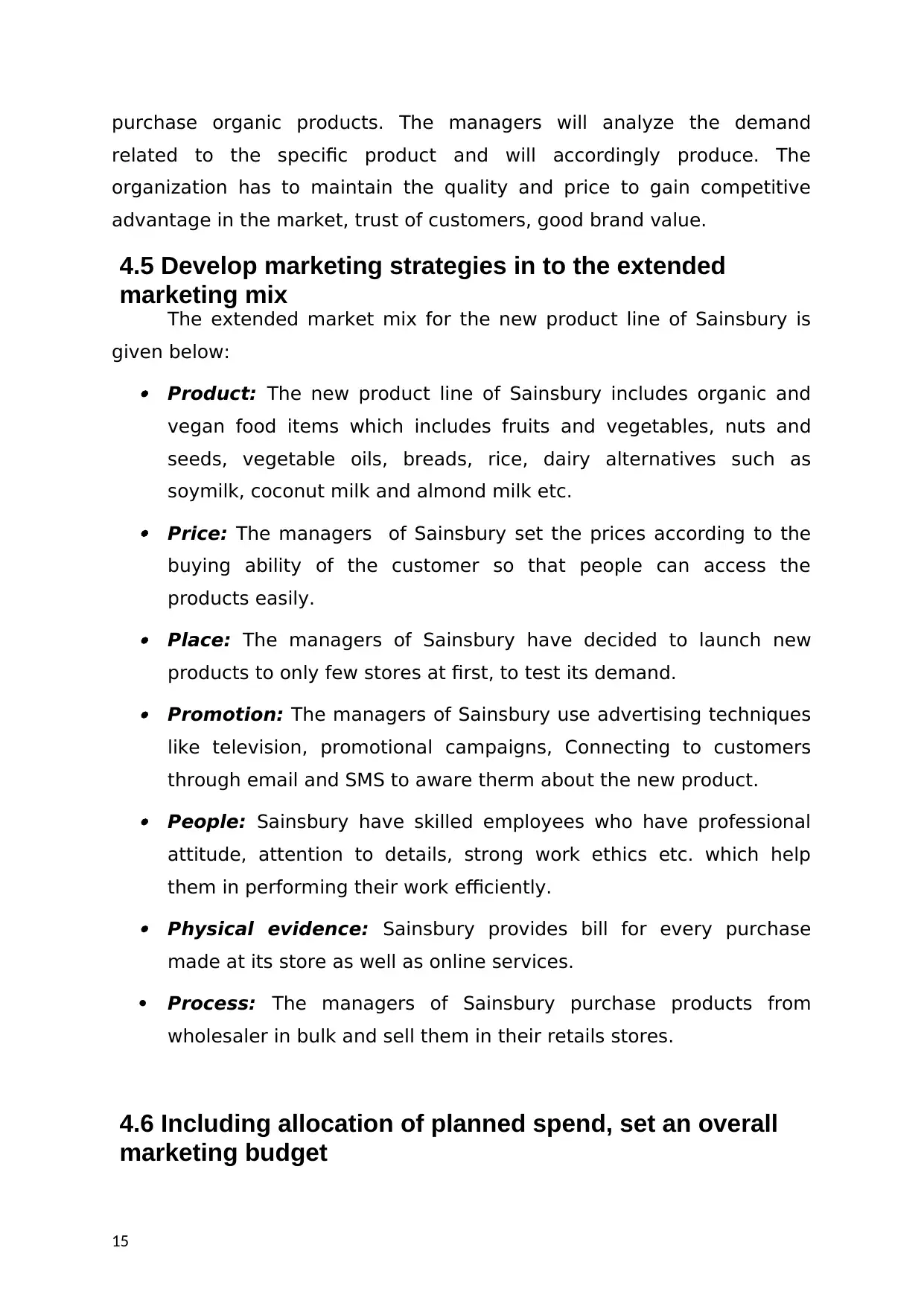
purchase organic products. The managers will analyze the demand
related to the specific product and will accordingly produce. The
organization has to maintain the quality and price to gain competitive
advantage in the market, trust of customers, good brand value.
4.5 Develop marketing strategies in to the extended
marketing mix
The extended market mix for the new product line of Sainsbury is
given below: Product: The new product line of Sainsbury includes organic and
vegan food items which includes fruits and vegetables, nuts and
seeds, vegetable oils, breads, rice, dairy alternatives such as
soymilk, coconut milk and almond milk etc. Price: The managers of Sainsbury set the prices according to the
buying ability of the customer so that people can access the
products easily. Place: The managers of Sainsbury have decided to launch new
products to only few stores at first, to test its demand. Promotion: The managers of Sainsbury use advertising techniques
like television, promotional campaigns, Connecting to customers
through email and SMS to aware therm about the new product. People: Sainsbury have skilled employees who have professional
attitude, attention to details, strong work ethics etc. which help
them in performing their work efficiently. Physical evidence: Sainsbury provides bill for every purchase
made at its store as well as online services.
Process: The managers of Sainsbury purchase products from
wholesaler in bulk and sell them in their retails stores.
4.6 Including allocation of planned spend, set an overall
marketing budget
15
related to the specific product and will accordingly produce. The
organization has to maintain the quality and price to gain competitive
advantage in the market, trust of customers, good brand value.
4.5 Develop marketing strategies in to the extended
marketing mix
The extended market mix for the new product line of Sainsbury is
given below: Product: The new product line of Sainsbury includes organic and
vegan food items which includes fruits and vegetables, nuts and
seeds, vegetable oils, breads, rice, dairy alternatives such as
soymilk, coconut milk and almond milk etc. Price: The managers of Sainsbury set the prices according to the
buying ability of the customer so that people can access the
products easily. Place: The managers of Sainsbury have decided to launch new
products to only few stores at first, to test its demand. Promotion: The managers of Sainsbury use advertising techniques
like television, promotional campaigns, Connecting to customers
through email and SMS to aware therm about the new product. People: Sainsbury have skilled employees who have professional
attitude, attention to details, strong work ethics etc. which help
them in performing their work efficiently. Physical evidence: Sainsbury provides bill for every purchase
made at its store as well as online services.
Process: The managers of Sainsbury purchase products from
wholesaler in bulk and sell them in their retails stores.
4.6 Including allocation of planned spend, set an overall
marketing budget
15
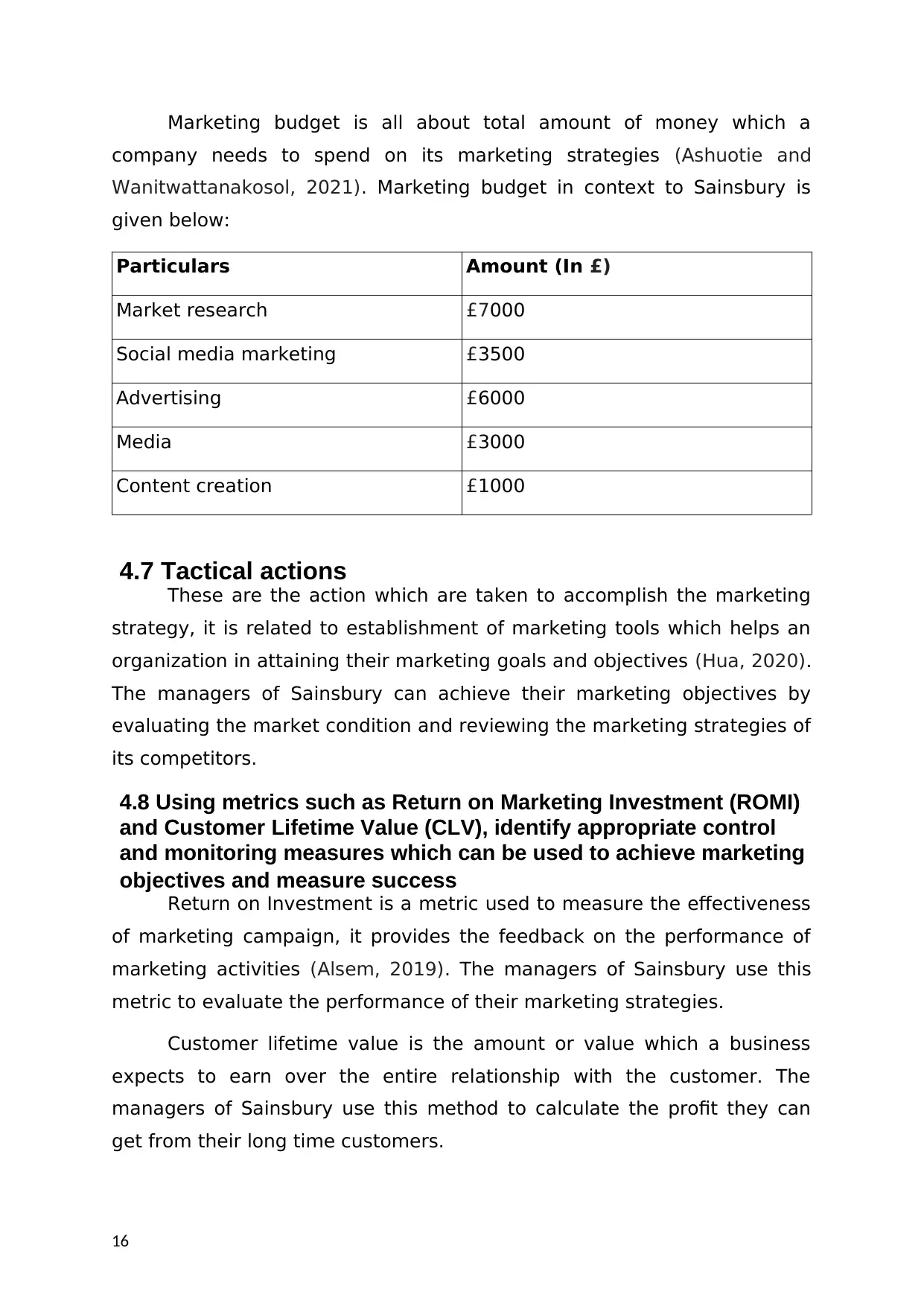
Marketing budget is all about total amount of money which a
company needs to spend on its marketing strategies (Ashuotie and
Wanitwattanakosol, 2021). Marketing budget in context to Sainsbury is
given below:
Particulars Amount (In £)
Market research £7000
Social media marketing £3500
Advertising £6000
Media £3000
Content creation £1000
4.7 Tactical actions
These are the action which are taken to accomplish the marketing
strategy, it is related to establishment of marketing tools which helps an
organization in attaining their marketing goals and objectives (Hua, 2020).
The managers of Sainsbury can achieve their marketing objectives by
evaluating the market condition and reviewing the marketing strategies of
its competitors.
4.8 Using metrics such as Return on Marketing Investment (ROMI)
and Customer Lifetime Value (CLV), identify appropriate control
and monitoring measures which can be used to achieve marketing
objectives and measure success
Return on Investment is a metric used to measure the effectiveness
of marketing campaign, it provides the feedback on the performance of
marketing activities (Alsem, 2019). The managers of Sainsbury use this
metric to evaluate the performance of their marketing strategies.
Customer lifetime value is the amount or value which a business
expects to earn over the entire relationship with the customer. The
managers of Sainsbury use this method to calculate the profit they can
get from their long time customers.
16
company needs to spend on its marketing strategies (Ashuotie and
Wanitwattanakosol, 2021). Marketing budget in context to Sainsbury is
given below:
Particulars Amount (In £)
Market research £7000
Social media marketing £3500
Advertising £6000
Media £3000
Content creation £1000
4.7 Tactical actions
These are the action which are taken to accomplish the marketing
strategy, it is related to establishment of marketing tools which helps an
organization in attaining their marketing goals and objectives (Hua, 2020).
The managers of Sainsbury can achieve their marketing objectives by
evaluating the market condition and reviewing the marketing strategies of
its competitors.
4.8 Using metrics such as Return on Marketing Investment (ROMI)
and Customer Lifetime Value (CLV), identify appropriate control
and monitoring measures which can be used to achieve marketing
objectives and measure success
Return on Investment is a metric used to measure the effectiveness
of marketing campaign, it provides the feedback on the performance of
marketing activities (Alsem, 2019). The managers of Sainsbury use this
metric to evaluate the performance of their marketing strategies.
Customer lifetime value is the amount or value which a business
expects to earn over the entire relationship with the customer. The
managers of Sainsbury use this method to calculate the profit they can
get from their long time customers.
16
Secure Best Marks with AI Grader
Need help grading? Try our AI Grader for instant feedback on your assignments.
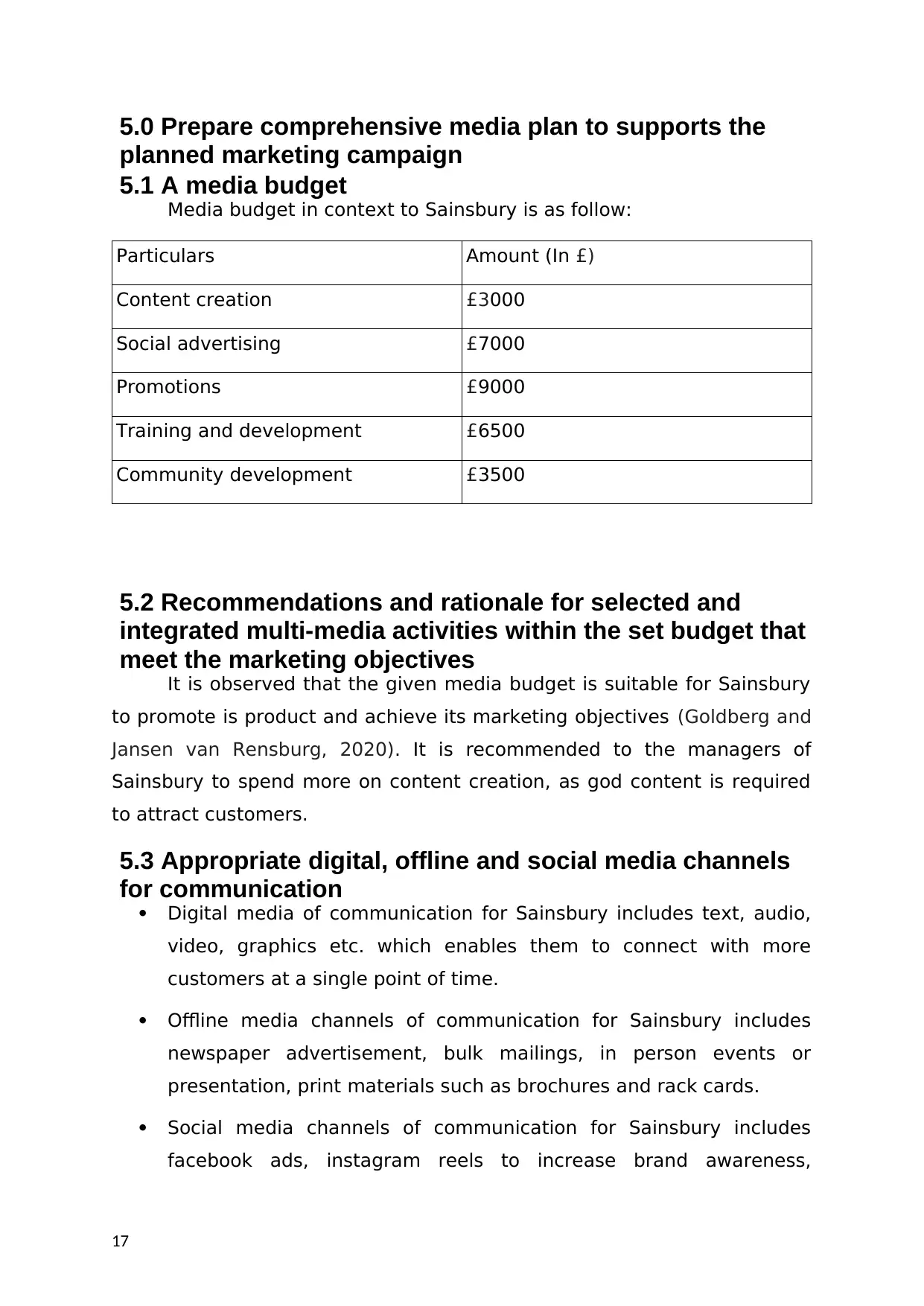
5.0 Prepare comprehensive media plan to supports the
planned marketing campaign
5.1 A media budget
Media budget in context to Sainsbury is as follow:
Particulars Amount (In £)
Content creation £3000
Social advertising £7000
Promotions £9000
Training and development £6500
Community development £3500
5.2 Recommendations and rationale for selected and
integrated multi-media activities within the set budget that
meet the marketing objectives
It is observed that the given media budget is suitable for Sainsbury
to promote is product and achieve its marketing objectives (Goldberg and
Jansen van Rensburg, 2020). It is recommended to the managers of
Sainsbury to spend more on content creation, as god content is required
to attract customers.
5.3 Appropriate digital, offline and social media channels
for communication
Digital media of communication for Sainsbury includes text, audio,
video, graphics etc. which enables them to connect with more
customers at a single point of time.
Offline media channels of communication for Sainsbury includes
newspaper advertisement, bulk mailings, in person events or
presentation, print materials such as brochures and rack cards.
Social media channels of communication for Sainsbury includes
facebook ads, instagram reels to increase brand awareness,
17
planned marketing campaign
5.1 A media budget
Media budget in context to Sainsbury is as follow:
Particulars Amount (In £)
Content creation £3000
Social advertising £7000
Promotions £9000
Training and development £6500
Community development £3500
5.2 Recommendations and rationale for selected and
integrated multi-media activities within the set budget that
meet the marketing objectives
It is observed that the given media budget is suitable for Sainsbury
to promote is product and achieve its marketing objectives (Goldberg and
Jansen van Rensburg, 2020). It is recommended to the managers of
Sainsbury to spend more on content creation, as god content is required
to attract customers.
5.3 Appropriate digital, offline and social media channels
for communication
Digital media of communication for Sainsbury includes text, audio,
video, graphics etc. which enables them to connect with more
customers at a single point of time.
Offline media channels of communication for Sainsbury includes
newspaper advertisement, bulk mailings, in person events or
presentation, print materials such as brochures and rack cards.
Social media channels of communication for Sainsbury includes
facebook ads, instagram reels to increase brand awareness,
17
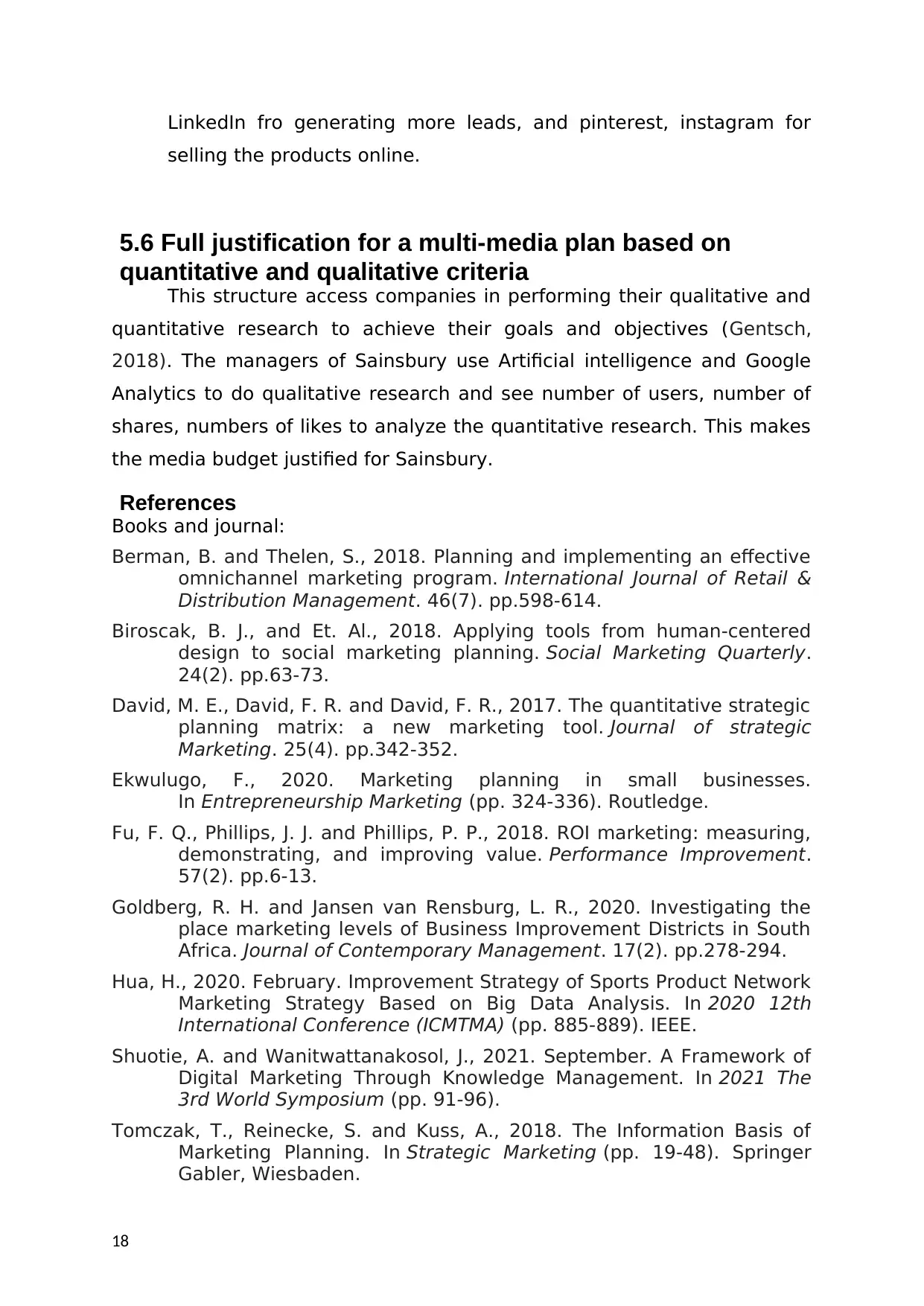
LinkedIn fro generating more leads, and pinterest, instagram for
selling the products online.
5.6 Full justification for a multi-media plan based on
quantitative and qualitative criteria
This structure access companies in performing their qualitative and
quantitative research to achieve their goals and objectives (Gentsch,
2018). The managers of Sainsbury use Artificial intelligence and Google
Analytics to do qualitative research and see number of users, number of
shares, numbers of likes to analyze the quantitative research. This makes
the media budget justified for Sainsbury.
References
Books and journal:
Berman, B. and Thelen, S., 2018. Planning and implementing an effective
omnichannel marketing program. International Journal of Retail &
Distribution Management. 46(7). pp.598-614.
Biroscak, B. J., and Et. Al., 2018. Applying tools from human-centered
design to social marketing planning. Social Marketing Quarterly.
24(2). pp.63-73.
David, M. E., David, F. R. and David, F. R., 2017. The quantitative strategic
planning matrix: a new marketing tool. Journal of strategic
Marketing. 25(4). pp.342-352.
Ekwulugo, F., 2020. Marketing planning in small businesses.
In Entrepreneurship Marketing (pp. 324-336). Routledge.
Fu, F. Q., Phillips, J. J. and Phillips, P. P., 2018. ROI marketing: measuring,
demonstrating, and improving value. Performance Improvement.
57(2). pp.6-13.
Goldberg, R. H. and Jansen van Rensburg, L. R., 2020. Investigating the
place marketing levels of Business Improvement Districts in South
Africa. Journal of Contemporary Management. 17(2). pp.278-294.
Hua, H., 2020. February. Improvement Strategy of Sports Product Network
Marketing Strategy Based on Big Data Analysis. In 2020 12th
International Conference (ICMTMA) (pp. 885-889). IEEE.
Shuotie, A. and Wanitwattanakosol, J., 2021. September. A Framework of
Digital Marketing Through Knowledge Management. In 2021 The
3rd World Symposium (pp. 91-96).
Tomczak, T., Reinecke, S. and Kuss, A., 2018. The Information Basis of
Marketing Planning. In Strategic Marketing (pp. 19-48). Springer
Gabler, Wiesbaden.
18
selling the products online.
5.6 Full justification for a multi-media plan based on
quantitative and qualitative criteria
This structure access companies in performing their qualitative and
quantitative research to achieve their goals and objectives (Gentsch,
2018). The managers of Sainsbury use Artificial intelligence and Google
Analytics to do qualitative research and see number of users, number of
shares, numbers of likes to analyze the quantitative research. This makes
the media budget justified for Sainsbury.
References
Books and journal:
Berman, B. and Thelen, S., 2018. Planning and implementing an effective
omnichannel marketing program. International Journal of Retail &
Distribution Management. 46(7). pp.598-614.
Biroscak, B. J., and Et. Al., 2018. Applying tools from human-centered
design to social marketing planning. Social Marketing Quarterly.
24(2). pp.63-73.
David, M. E., David, F. R. and David, F. R., 2017. The quantitative strategic
planning matrix: a new marketing tool. Journal of strategic
Marketing. 25(4). pp.342-352.
Ekwulugo, F., 2020. Marketing planning in small businesses.
In Entrepreneurship Marketing (pp. 324-336). Routledge.
Fu, F. Q., Phillips, J. J. and Phillips, P. P., 2018. ROI marketing: measuring,
demonstrating, and improving value. Performance Improvement.
57(2). pp.6-13.
Goldberg, R. H. and Jansen van Rensburg, L. R., 2020. Investigating the
place marketing levels of Business Improvement Districts in South
Africa. Journal of Contemporary Management. 17(2). pp.278-294.
Hua, H., 2020. February. Improvement Strategy of Sports Product Network
Marketing Strategy Based on Big Data Analysis. In 2020 12th
International Conference (ICMTMA) (pp. 885-889). IEEE.
Shuotie, A. and Wanitwattanakosol, J., 2021. September. A Framework of
Digital Marketing Through Knowledge Management. In 2021 The
3rd World Symposium (pp. 91-96).
Tomczak, T., Reinecke, S. and Kuss, A., 2018. The Information Basis of
Marketing Planning. In Strategic Marketing (pp. 19-48). Springer
Gabler, Wiesbaden.
18
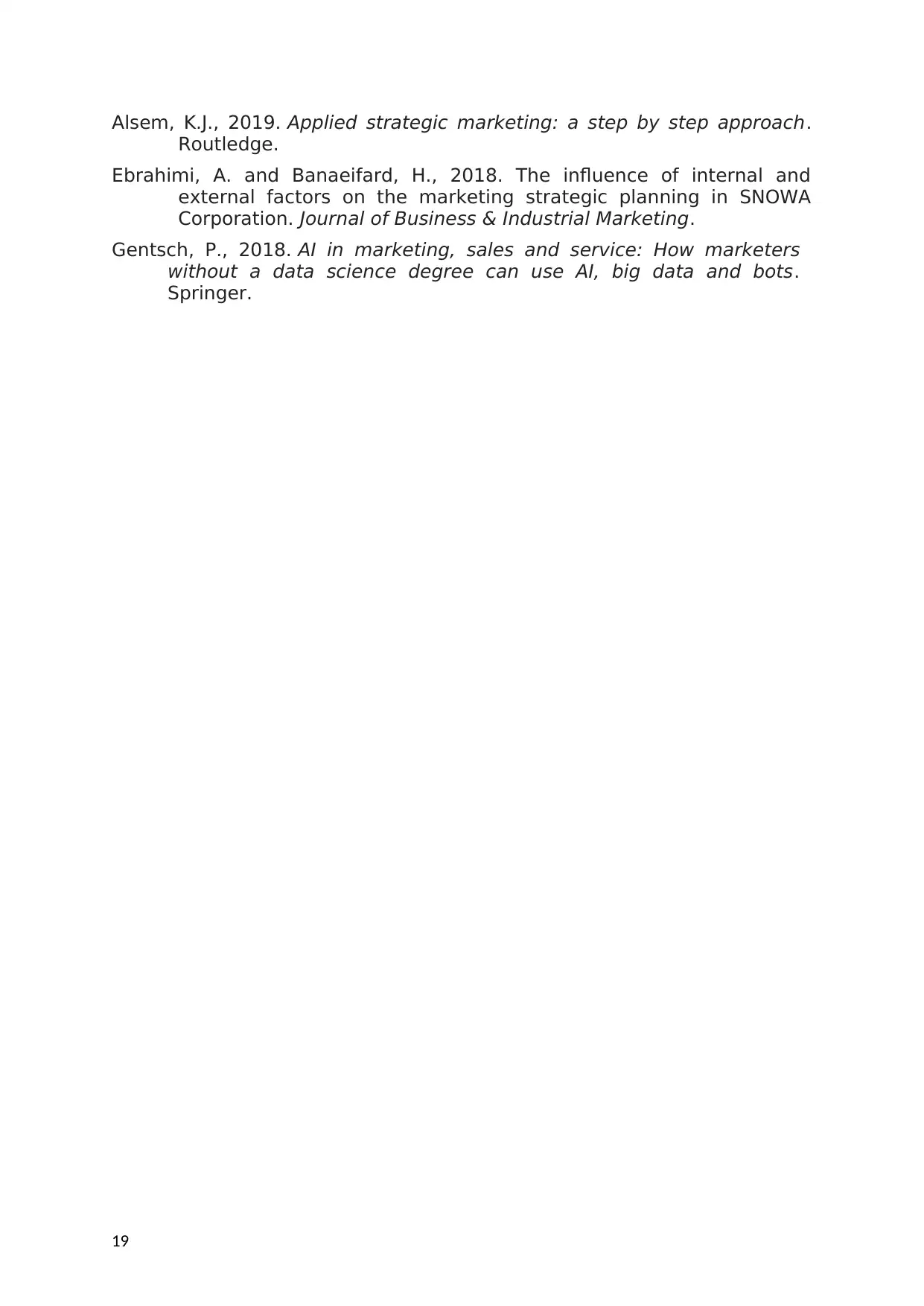
Alsem, K.J., 2019. Applied strategic marketing: a step by step approach.
Routledge.
Ebrahimi, A. and Banaeifard, H., 2018. The influence of internal and
external factors on the marketing strategic planning in SNOWA
Corporation. Journal of Business & Industrial Marketing.
Gentsch, P., 2018. AI in marketing, sales and service: How marketers
without a data science degree can use AI, big data and bots.
Springer.
19
Routledge.
Ebrahimi, A. and Banaeifard, H., 2018. The influence of internal and
external factors on the marketing strategic planning in SNOWA
Corporation. Journal of Business & Industrial Marketing.
Gentsch, P., 2018. AI in marketing, sales and service: How marketers
without a data science degree can use AI, big data and bots.
Springer.
19
1 out of 19
Related Documents
Your All-in-One AI-Powered Toolkit for Academic Success.
+13062052269
info@desklib.com
Available 24*7 on WhatsApp / Email
![[object Object]](/_next/static/media/star-bottom.7253800d.svg)
Unlock your academic potential
© 2024 | Zucol Services PVT LTD | All rights reserved.


